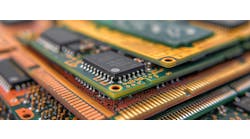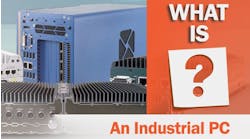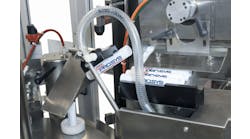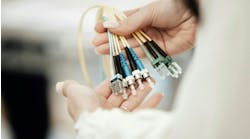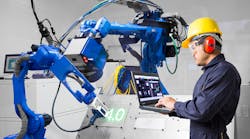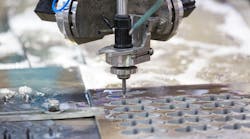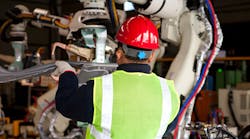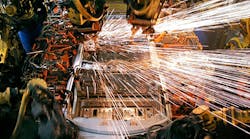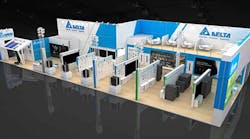Latest from Learning Center
Predictive Maintenance Learning Center
Top Manufacturing Stories of 2024
Best Manufacturing Guides of 2024
What Is an Industrial PC?
Fabricating metal provides an ideal use case for automation. Processes often are repetitive and require a high amount of precision – the perfect working conditions for an industrial robot. Laser cutting, in particular, can see significant improvements from introducing automation into the equation.
As helpful as factory automation can be, it requires a substantial amount of forethought. The three most common barriers to automation are each cost-related, as robotics have high upfront costs and typically take a while to produce a positive ROI. If you hope to make the most of these investments, you should plan their implementation carefully.
Here are five steps you can follow to add automation to your laser-cutting processes effectively.
1. Automate Front-End Tasks
One challenge machinists often run into after implementing automation is new, unintentional bottlenecks. Automated laser-cutting systems can produce two to four times more parts in the same time as manual processes. If the rest of your workflow does not likewise accelerate, the differences in speed will restrict your overall productivity.
The solution here is to automate front-end tasks like data entry and processing through robotic process automation (RPA.) Employing software robots will ensure your order management can keep pace with the rest of your factory automation. Consequently, you’ll prevent bottlenecks from occurring around your laser-cutting processes and improve your total efficiency.
Implementing RPA in addition to laser-cutting robots will mean higher upfront costs and potentially more disruption before employees get used to new workflows. At the same time, it will lead to more dramatic efficiency improvements, generating a positive ROI sooner. That way, you get all you can out of your robotics investments.
2. Program for Material Efficiency
Automation alone will not necessarily lead to remarkable productivity improvements. The efficiency of your automated laser-cutting system largely depends on how you program it. When the time comes to program your robots, aim for higher material efficiency, requiring pre-set material yields wherever possible.
Many machines can be programmed to use a stated percentage of the materials for each sheet of metal. Doing this will ensure you create more parts per sheet, minimizing waste and eventually leading to reduced material costs. While this programming may not speed up your metal fabrication process, it will increase profits by lowering expenses.
Another step to raise your laser-cutting efficiency is to combine orders based on like materials and thicknesses. Remember, though, that metal thickness determines cutting speed, so if you combine multiple orders on a thick sheet, it will slow down the process. Plan your production schedule accordingly to accommodate your machine’s varying cutting speeds when stacking orders.
3. Purchase Equipment in Stages
Another thing to consider when automating metal fabrication processes is how you can offset the costs. One of the most effective cost mitigation strategies with factory automation is to automate in stages instead of all at once. While it may be tempting to apply automation everywhere from the start, this will incur high costs and likely will disrupt your workflows.
Many automated laser-cutting systems are modular, allowing you to automate one part of the process at a time. Start with the area with the highest potential for savings, then slowly automate other, lower-priority tasks. As you automate further, remember to use worker feedback to scale up more effectively.
A 2020 survey found that 65% of successful automation initiatives used people’s feedback to train automation solutions, compared to just 24% of unsuccessful operations. Embracing a slow, modular approach to automation while using workers’ experience to guide you will mitigate costs and lead to higher ROIs.
4. Automate Loading and Unloading
As you automate, remember to consider more than just the cutting process itself. Just as front-end bottlenecks can limit laser cutting automation’s efficiency, so can later processes like unloading. Loading and unloading may not seem like time-consuming tasks, but they’re easy to automate, and small changes can lead to considerable improvements over time.
You may be able to automate loading and unloading with little more than a conveyor belt. Even more delicate operations likely will not need more than a robotic arm and some sensors to guide it. These motions are simple and repetitive, making them ideal for automation. Automating them will ensure the entire line can match the laser cutter’s efficiency.
While they may seem like minor tasks, loading and unloading are common points of inefficiency. Automating them can take your beam-on time up to 80% or more, while average times linger around 30% to 40%. If you don’t automate loading and unloading, you’re not using your laser cutting automation to its fullest extent.
5. Monitor Key Performance Indicators
One of the most common mistakes in factory automation is overlooking the importance of KPIs. Many shops will automate without measuring their performance before or after, hindering the efficacy of these investments. If you hope to make wise automation decisions, you must thoroughly monitor the processes under consideration.
Before automating, gather data on your metal fabrication KPIs to establish a baseline for comparison. After introducing any type of automation capability, continue to monitor those KPIs, looking for both positive and negative changes. Any differences will reveal the extent to which your automation was effective, guiding your future automation decisions.
Without benchmarking data, it will be difficult to understand how automation improved your processes. If you don’t have quantifiable data to reference, you’ll end up relying primarily on guesswork when trying to replicate past successes or avoid making the same failures. As such, it is essential that you monitor KPIs before and after automating.
Proper Planning Maximizes Automation’s Potential
Metal fabrication may be an ideal application for automation, but these benefits will not come automatically. Effective factory automation relies on thorough planning and careful implementation. If you follow these steps, you can use maximize the value and performance of laser cutting automation – and mitigate any related challenges.
Automation can be expensive and intimidating, but with the right approach, it does not have to cause much disruption. These guidelines will help you see how to implement automation most effectively, minimizing upfront costs and accelerating ROIs. You can then be sure your investment will deliver all it can.
Emily Newton is the Editor-in-Chief of Revolutionized, an online magazine exploring the latest industrial innovations.





